[social_warfare]
The whale shark isn’t your average fish. It’s like the ocean decided to go big or go home, creating the largest fish that swims our seas today. They are the prime definition of the ocean’s very own gentle giant.
Let’s unravel the mysteries of these fascinating creatures together, shall we?
What is the Whale Shark?
Officially known as Rhincodon typus, the whale shark holds the title in the heavyweight category, yet it’s as gentle as a giant can get. This majestic creature roams the tropical oceans of the world, filtering tons of water for plankton and small fish to eat.
Despite their mammoth size, there’s nothing to fear from these peaceful beasts; they’re the ocean’s filter-feeders, calmly cruising through the water.
What do Whale Sharks Look Like?
Imagine a bus. Now, imagine it’s swimming in the ocean with spots. That’s pretty much a whale shark for you. These guys can grow up to 40 feet long (some even say 60 feet!), making them the biggest fish in the sea. But it’s not just their size that’s impressive. Whale sharks have a broad, flat head, a wide mouth that can stretch up to 4 feet wide, and a body covered in a beautiful pattern of white spots and stripes. These spots are like fingerprints; no two whale sharks have the same pattern.
Their skin is as thick as rubber, and those unique patterns aren’t just for show; they help camouflage the whale shark in the sun-dappled water, breaking up their outline to any potential predators lurking below. And let’s not forget about their tail, which is massive and powerful, propelling them through the ocean with slow, languid movements. They’re the epitome of “floating like a butterfly, stinging like a bee” – if, you know, they actually stung and weren’t just big, docile fish.

So, are they Whales or Sharks?
So, the million-dollar question: Are they whales or sharks? Despite their name and size, whale sharks are sharks. But let’s not hold the “shark” part against them; these creatures are about as far from the “Jaws” stereotype as you can get. Being part of the shark family means they’ve got cartilage instead of bones, which is pretty standard in the shark playbook. But unlike their often-feared cousins, whale sharks are filter feeders, meaning they’re more interested in plankton than anything else.
So why the name “whale” shark? It’s all about the size, folks. These creatures are as large as some species of whales, and just like whales, they filter feed. But make no mistake, they’re 100% shark, just the kind you’d love to meet face to face.
How Big are Whale Sharks?
Okay, picture this: you’re snorkeling in the clear blue, and a shadow engulfs you—a shadow as big as a school bus. No need to panic; it’s just a friendly whale shark, casually passing by. These guys can stretch up to 40 feet on average, with some legends reaching a whopping 60 feet or more. That’s longer than a professional basketball court. Imagine playing a game on the back of one of these creatures! Their enormous size doesn’t make them fast swimmers, though. They prefer the chill life, moving through the water at a leisurely pace, which is fantastic news for awe-struck snorkelers and divers hoping to catch a glimpse.
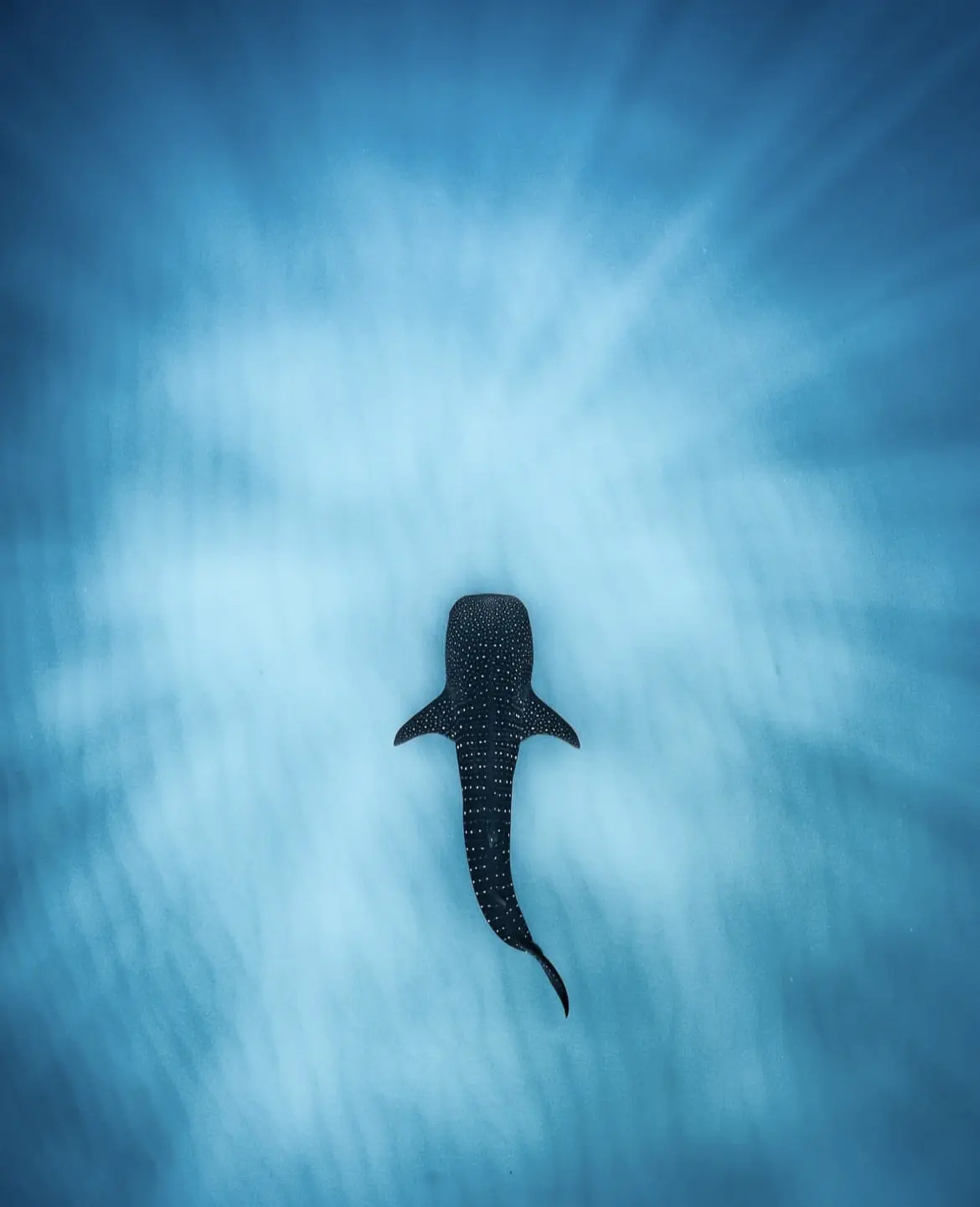
Whale Shark Skin
Let’s talk about their skin for a sec. It’s not just any skin; it’s a thick, tough hide that can be up to 4 inches thick. That’s like having a natural suit of armor. This tough exterior is speckled with those beautiful white spots and stripes we mentioned earlier, making each whale shark uniquely identifiable. But it’s not just about looks. This skin is designed to protect them from the harsh realities of ocean life, including pesky parasites and would-be predators. Plus, their skin helps with hydrodynamics, allowing them to glide effortlessly through the water despite their massive size.
Whale Shark Teeth
Now, onto their teeth, because yes, they have them, and no, they’re nothing to worry about. Whale sharks have thousands of tiny teeth (about 3,000!), but they’re not for chewing. These teeth are so small they’re almost like bristles. Remember, whale sharks are filter feeders. They open their gigantic mouths to scoop up tons of water, which they then filter out through their gills, trapping plankton, small fish, and other sea snacks. It’s like they’re living the dream, swimming with their mouths open, catching all the food they want without lifting a fin. So, despite having all those teeth, they’re as harmless as a fish can be.
Do Whale Sharks make sounds?
When it comes to the ocean’s giants, we often hear about the haunting songs of whales. But what about whale sharks? Do these massive fish serenade the ocean depths? Well, not quite. Whale sharks are the strong, silent type. They don’t produce sounds that humans can hear, as they communicate and navigate their world in different ways, primarily through body movements and possibly through sensing vibrations in the water. This silence adds to their mystique, making encounters with them even more magical and serene. You won’t hear them coming, but spotting the shadow of a whale shark approaching is a moment of awe and silence you’ll never forget.

Whale Shark Colouration
Moving on to something a bit more visible: their stunning coloration. Whale sharks are truly works of art. Their backs are a mesmerizing shade of blue or blue-gray, adorned with a constellation of white spots and stripes. These aren’t just for show; they play a crucial role in camouflaging these giants from predators lurking below, breaking up their silhouette in the dappled sunlight of the ocean’s surface. This unique pattern is also a key way researchers identify and track individual whale sharks, as no two sharks have the exact same spot arrangement. It’s their own natural barcode, making each one as unique as a fingerprint.
What do Whale Sharks Eat?
Now, onto a favorite topic: food. What does a creature this large feast on to maintain its size? You might be surprised to learn that whale sharks are the ocean’s vacuum cleaners, filtering tiny plankton, krill, small fish, and squid from the water. They feed by swimming with their enormous mouths open, engulfing everything in their path, then filtering the water out through their gills, trapping their microscopic meals inside. This gentle giant, the largest fish in the sea, relies on some of the smallest organisms for nourishment. It’s a fascinating contrast that highlights the diversity and balance of marine ecosystems. Whale sharks can also feed by vertically bobbing up and down in the water, sucking in volumes of water rich in food. So, despite their intimidating size, these sharks have a diet that’s anything but fearsome.

Whale Shark Social Structure
When you picture the vast, open ocean, it’s easy to imagine whale sharks as solitary nomads, wandering the depths alone. And while it’s true that they often travel solo, these giants are known to come together in groups for feeding. Spots where plankton blooms are abundant, like in the waters off Mexico’s Yucatán Peninsula or the Ningaloo Reef in Australia, can become whale shark hotspots, drawing dozens of them to feast together. This social behavior suggests that while whale sharks enjoy their solitude, they’re not averse to sharing a good meal with their kind. It’s like the marine version of a pop-up gourmet food festival, where the main course is plankton!
How do Whale Sharks Reproduce?
Reproduction among whale sharks remains one of the ocean’s best-kept secrets. What we do know comes from rare observations and even rarer captures. Whale sharks are ovoviviparous, meaning the females lay eggs, but these eggs hatch inside the mother, and she gives birth to live young. A single female can carry hundreds of embryos but will give birth to live pups at different stages of development. This fascinating reproductive strategy ensures the survival of at least some offspring in the vast and perilous ocean. The details of their mating rituals, pregnancy, and birthing locations are still largely shrouded in mystery, leaving scientists and marine biologists eager to learn more about these elusive aspects of their life cycle.
How Long do Whale Sharks Live?
Estimating the lifespan of whale sharks is tricky, but recent research suggests these gentle giants could live up to 100 to 150 years, maybe more. Determining age in whale sharks can be done by counting the growth rings in their vertebrae, much like counting the rings of a tree, but it’s not an exact science. Their long lifespan is a testament to their resilience and adaptability in the ocean’s ever-changing environment. However, it also means they grow and mature slowly, reaching sexual maturity at around 30 years of age. This slow journey to adulthood has significant implications for their population recovery and conservation efforts, highlighting the importance of protecting these magnificent creatures throughout their lengthy lives.
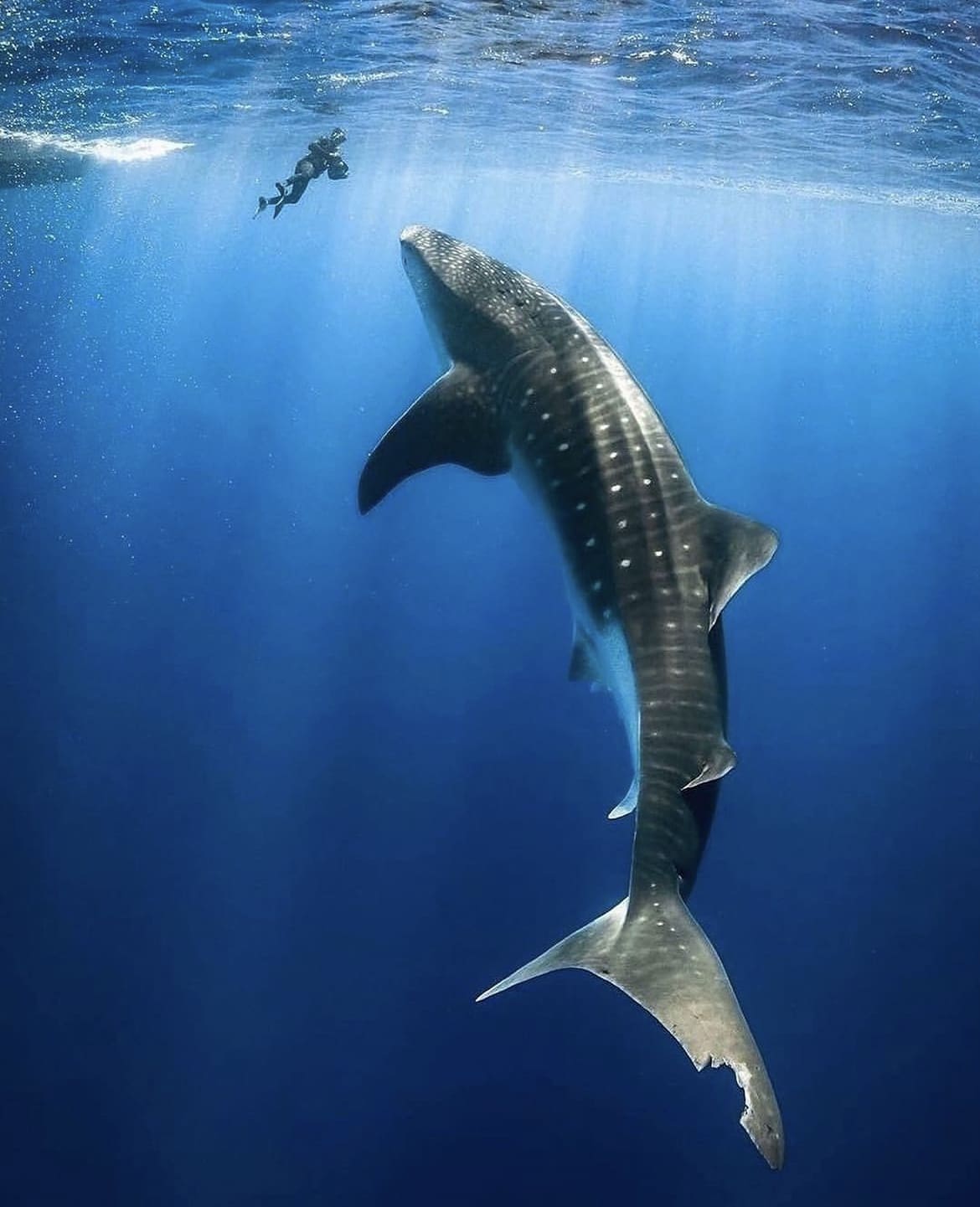
Are Whale Shark’s Dangerous?
The term “shark” might send a shiver down your spine, but when it comes to whale sharks, there’s no need for fear. Despite their impressive size, whale sharks are incredibly gentle and pose no real threat to humans. They’re filter feeders, more interested in tiny plankton than anything else. Divers and snorkelers from around the globe seek encounters with these magnificent creatures, often describing the experience as peaceful and awe-inspiring. So, if you’re lucky enough to swim with a whale shark, worry not; they’re the gentle giants of the sea, more likely to swim away from you than to cause any harm.
Are Whale Sharks Territorial?
In the vast expanse of the ocean, whale sharks roam freely, following the bloom of plankton and the warmth of the waters. They are not known to be territorial creatures. Unlike many animals that fiercely defend their home range, whale sharks exhibit nomadic behavior, migrating thousands of miles in search of food. Their travels take them across oceans and hemispheres, from the tropical waters of the Caribbean to the warm seas of Southeast Asia and beyond. This lack of territoriality underscores their role as gentle wanderers of the sea, always on the move, yet at peace in the open water.
How Fast are Whale Sharks?
Don’t let their massive size fool you; whale sharks are not setting any speed records. Their typical cruising speed is about 3 miles per hour, a leisurely pace that matches their tranquil demeanor. They glide through the water with a calm and steady grace, propelled by the undulating movements of their massive tail fin. This speed allows them to efficiently filter feed as they travel, sucking in water and plankton without the rush. While they can burst to higher speeds when needed, they prefer the slow lane, savoring the ocean’s buffet at a pace that lets them take in everything around them.
Where do Whale Sharks Live?
Whale sharks have a passport filled with stamps from all around the world. These globetrotters prefer warm waters and are found in all tropical and warm-temperate seas. From the coral-rich waters of the Philippines to the nutrient-packed Gulf of Mexico and the biodiverse hotspots like the Galápagos Islands, whale sharks cover a vast geographical range. They’re known to migrate thousands of miles to find food and possibly to breed, though their breeding grounds remain one of the ocean’s secrets. Whale sharks are most commonly found near the equator, where they can dive to depths of over 1,000 meters but often stay near the surface to feed on plankton and small fish.
How Many Whale Sharks are There in the Wild?
Quantifying the exact number of whale sharks in the world’s oceans is a daunting task, fraught with challenges. However, conservationists and scientists use tagging and tracking technologies to estimate their populations. These gentle giants are considered endangered, with their numbers declining due to a range of human activities. Despite efforts to monitor their populations, exact numbers remain elusive, though the consensus is clear: their numbers are not what they once were, emphasizing the need for concerted global conservation efforts to ensure their survival.
Are Whale Sharks Endangered?
The IUCN (International Union for Conservation of Nature) classifies whale sharks as endangered. Their slow growth and late maturity, coupled with a low reproductive rate, make them particularly vulnerable to threats. Human impacts—such as accidental catches in fishing gear, targeted hunting for their fins and meat in some areas, and the degradation of their marine habitats—pose significant risks to their survival. The beauty and grace of whale sharks have made them popular in eco-tourism, which, while beneficial in raising awareness and funding for their conservation, also needs to be managed carefully to prevent stress and harm to these majestic creatures.
The plight of the whale shark is a poignant reminder of the interconnectedness of our ecosystems and the impact human activities can have on even the largest of ocean inhabitants. Protecting them is not just about preserving a single species but about maintaining the health and balance of the entire marine ecosystem. As we look ahead, the conservation of whale sharks becomes a beacon for broader oceanic conservation efforts, urging us to act thoughtfully and swiftly to protect our blue planet’s gentle giants.
Threats to Whale Sharks in the Wild
The serene existence of whale sharks is increasingly disturbed by human activities. Beyond the direct threats of fishing and bycatch, whale sharks face the invisible menace of ocean pollution, including plastic waste, which can harm them when ingested. Climate change also poses a significant threat, altering ocean temperatures and impacting the distribution of plankton, which could affect whale shark migration patterns and feeding grounds. Efforts to protect these creatures are growing, with increased marine protected areas and stricter regulations on fishing practices, but the race against time and human impact continues.
Where to Dive with Whale Sharks?
For those yearning to witness the majesty of whale sharks up close, there are several hotspots around the globe renowned for regular sightings. The Ningaloo Reef in Western Australia offers intimate encounters with these giants in crystal clear waters.
Similarly, the Philippines’ Donsol and Oslob have become famous for their whale shark tourism, offering snorkelers and divers a chance to swim alongside these peaceful behemoths.
The Caribbean waters off Isla Holbox and the Bay Islands of Honduras also provide spectacular opportunities to dive with whale sharks, especially during their migratory season.
Tips for Spotting Whale Sharks
Spotting a whale shark can be the experience of a lifetime, and while their sheer size might make them seem easy to find, knowing where and when to look can significantly increase your chances. First, timing is everything—aim for the peak season in known hotspots, usually around plankton blooms when whale sharks are most likely to be feeding at the surface. Additionally, keep an eye out for signs of their presence, such as flocks of seabirds feeding on fish disturbed by the shark’s massive feeding process.
Facts about The Whale Shark
- Whale sharks can process over 6,000 liters of water an hour through their gills while feeding.
- Despite their size, whale sharks have relatively small brains, emphasizing their gentle nature.
- They can travel across entire oceans, with some tagged whale sharks recorded making journeys of over 12,000 miles.
Myths about The Whale Shark
- Whale sharks can swallow a person whole: Completely false. Their throats are too small to swallow anything larger than a small fish.
- Whale sharks are aggressive: On the contrary, they are some of the most docile creatures in the ocean.
- Whale sharks are whales: As we’ve clarified, they are sharks, distinguished by their cartilaginous structure and gill slits.
